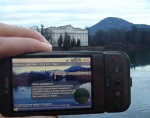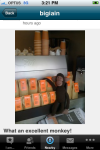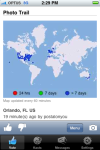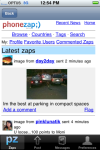April 23, 2010
Corporates finally catch on to the potential of location based services
Sadly the companies that were pioneers in location based services and have since fallen by the wayside due to the intolerably long period of time it took for GPS and other location technologies to become pervasive, will not benefit from the tide that is now turning. The geo-caching nerds out there will be thinking to themselves that this Business Insider article is nothing new. Everything that Gowalla stands for (in terms of enabling technologies) has been around for nearly 10 years now, perhaps more but it’s only really become attractive to corporates in the past 12-months because of the sheer volume of gps enabled mobile handsets that have been sold in the past 3 years. I’m excited to see this boom and I’m grateful that it has finally come but can’t help feel sorry for the pioneers. Clearly this is proof that it doesn’t always pay to be first to market and that timing is indeed everything.
April 20, 2010
Augmented reality is experimental at best and that’s a good thing.
Jeremiah Owyang called it, “at best experimental.” I see “it” as evolving faster than any mobile technology sector before. I’m referring, of course, to the mobile Augmented Reality (AR) market. Owyang, the well regarded ex-Forrester social media industry analyst, now charting a course on his own experimental waters, must surely see similarities to the origins of social media. The tools, technologies and real world applications Jeremiah has written about over the years are arguably still very much experimental in their own right but that doesn’t mean real world, robust use cases cannot be identified. It does, however, mean that currently there are numerous streams of innovation with the usual rush for world domination. Augmented reality is evolving at a relatively rapid pace. As with other online services, it’s still firmly all about you, I and the world around us, not brand names but the likes of 4square and Gowalla are clearly in the process of changing that with their local business centric model.
Experimental by definition implies something that is evolving based upon learning from past experience. Sounds like a similar story to a number of online and mobile industries that are currently re-inventing themselves.
With the daily hype surrounding twitter, we all should be forgiven for overlooking that social media began life as a genre where people interacted with other people online without influence or oversight from commercial interests. So too, current augmented reality applications are focused on exploring, learning and having fun for individuals as they move towards mainstream critical mass and the logical eventuality that large corporates will jump in to fund the next level of innovation.
In the meantime I’m happy just being able to view re-hashed web data in an AR view, thanks. It’s already adding value to my life with regular usage of apps such as Layar and Wikitude. I can find good watering holes on-the-go, take an ad-hoc history lesson and navigate my way around the city or suburbs.
As this recent article points out, AR’s next big challenge will be to establish a form of single source of data, rather than every company creating and often re-creating location based information in their own proprietary databases.
Sound familiar? Seems similar to the world of social media and the challenges of mobile social profile information but on an even shorter timescale. I’m personally hoping to see greater re-use of existing datasets in future, obviously with appropriate location and orientation content included, which hopefully will become an RDFa extension mandated by some form of standards body. The Open AR consortium may play a part, though I note that it’s homepage hasn’t been updated since January 2010.
More AR applications such as SREngine will soon add 2d scene recognition capabilities to AR applications. The pace of innovation is amazing but realistically all of this is simply a mobile version of what has been researched and applied for many years in the offline world and mobile devices are only now sporting enough processing power to deliver them on the road.
So before we see a raft of social media experts jumping on the AR bandwagon, let’s all plan to spend some time outdoors and enjoy the iphone and Android AR apps we have.
January 5, 2010
Will a new iPhone bring more innovative location services in 2010?
I stumbled across this brief but interesting PC World article recently, which covers a possible ‘sighting’ of an iPhone 3.0 in the wild. Whilst purely conjecture, it does open up the possibility that we’ll see a new iphone device ship this year that will come with more out-of-the-box location based services, specifically targeted around the GPS and magnetometer functions. No doubt augmented reality applications will play a central part but obviously we’d expect some new level of accuracy and capability for it to stand above an already crowded but still evolving AR landscape for the current generation of iphone and Android handsets.
Given Apple’s history in innovation, I’m excited. I think it would give augmented reality a head-start toward ubiquitous usage across the general public, rather than taking the usual road of 5 years early adoption and fragmentation before reaching critical mass. It may help sort out the current disarray in the myriad of data formats available to support publishing AR information via more notable platforms such as Wikitude and Layar.
August 3, 2009
Interview: Mobilizy’s Mark Kramer on establishing Wikitude as a mobile augmented reality platform
In this second interview of the mobile AR industry series, I interview Mark Kramer from Mobilizy. Some of you would already know them from the release of their leading mobile AR browser, Wikitude world browser, currently available for the Android platform and soon coming to an iPhone and Symbian device near you. You’ll see from the interview that Mobilizy take a different strategic and technical direction to their current major competitor, Layar from SPRXmobile.
I hope you enjoy the insights Mark provides into the workings of the agile, tight-knit team over at Mobilizy.
@siddey: Mark, thanks for fitting me into your hectic schedule to talk about about Mobilizy and the Wikitude world browser for mobile devices for Geographically Challenged. Since we first started corresponding I appreciate you’ve gone to great lengths to make this happen.
@MAMK: I would like to thank Geographically Challenged (from down-under) for asking me/Mobilizy to be a part of this interview series.
@siddey: Firstly, can you tell us a little about your role at Mobilizy?
@MAMK: Generally speaking, Mobilizy designs, develops and implements mobile solutions for location-based services and mobile augmented reality scenarios. I recently joined Mobilizy as the product strategist and human experience lead for WIKITUDE, our flagship project. My role is to engage and communicate directly with our user base in order to develop strategies to improve and enhance the WIKITUDE AR experience.
@siddey: We’ve seen a huge amount of press coverage both on and offline relating to augmented reality in recent months, most of which describes the wikitude browser and a competing application called Layar from SPRX mobile.
Why do you think people are now seemingly so excited about the availability of AR on mobile devices?
@MAMK: We have been working in the mobile AR space for a quite a while now and are excited about mobile augmented reality and location based services because it allows people to place information within a situational context. I believe that people are excited about the availability of AR because it is a more natural way to interact with information in physical spaces. We must not forget, this is just the beginning of an era in which we go beyond Web 2.0 and look towards helping shape the world as a platform. Mobilizy is trying to make it easier for everyone to access and visualize information in the physical world, this is why we believe that the world IS the platform!
@siddey: Mobilizy appears to be taking an extremely open approach to expanding the reach of, and content available within, the wikitude platform. We’re seeing this currently through the primary channels of the wikitude.me community website and also via a de-centralised model with the re-distributable Wikitude control that will allow 3rd party developers to integrate Wikitude features into their own products, whereas your competitors appear more centrally aligned to commercial content interests in seeking content hosting and advertising partnerships.
How do you see your business model differing from your competition and where do you expect the majority of revenue will come from?
@MAMK: Yes our approach is extremely open: Everyone can add data through our recently lauched map-based Website wikitude.me. However our openess goes far beyond that. A few days ago we lauched our Wikitude API (currently in beta). Wikitude API is extremely interesting for 3rd party developers because it enhances their existing mobile applications with AR capabilities.
As an example, take a developer who has already implemented an application displaying geotagged information (points of interest) on a map, and wants to enhance the application by adding an Augmented Reality camera view. Before the WIKITUDE API was available, he would have to reinvent the wheel by creating an AR camera view for their application. Now, anyone can throw in points of interest that are part of any application, connect with the WIKITUDE API and have it displayed through the exciting WIKITUDE camera view. All one needs to do is request the API package from Mobilizy and add the points of interest through the WIKITUDE API interface – that’s all! As a result, any application can be enhanced with WIKITUDE with hardly any effort! Our API is currently in Beta, so any comments or feature requests from developers using the API are very welcome.
There will not only be one Wikitude, there will be hundreds of exciting apps that make use of this exciting technology through the Wikitude API. And we know that we need the community to come up with the most brilliant AR ideas to bring AR to the next level. Our vision is to become a standard for AR development. We see each other as a key enabler of location-based AR solutions. And this is where the majority of revenue will come from.
@siddey: Wikitude.me appears to be a white-labelled version of the geo-location community website, Mobeedo. Can you shed some light on what sort of agreement you have with them in terms of ownership of the intellectual property for content submitted through mobeedo for the purposes of accessing through wikitude?
@MAMK: Wikitude.me is a collaborative effort, not a white-label platform. WIKITUDE and Mobeedo teamed up to create Wikitude.me in order to provide a free, easy-to-use, open, mobile information platform for anybody who wants to access or provide location based and situation-specific information or services via mobile phones.
Basically, Wikitude.me can be understood as a platform which anybody can contribute to freely, very similar to the philosophy of Wikipedia, but for mobile augmented reality. With regards to intellectual property, Wiktude.me will be implemented under a Creative Commons Attribution-Sharealike 3.0 Unported License. Mobilizy will be launching a Wikitude.biz platform for commercial purposes in the near future.
@siddey: In recent weeks we saw Apple open its camera API to 3rd party developers in the OS3.1 beta, apparently as a direct result of all the notable forces in AR banding together to petition Apple to make this available. Can you explain to GC readers why this action was so critical to being able to release AR applications such as wikitude for the iphone?
@MAMK: The iPhone OS camera API is critical in order to release WIKITUDE for the iPhone because the camera API would be the cornerstone of any augmented reality experience. Without the camera view you couldn’t see the information “overlay” and you would not be engaged in an augmented/mixed reality experience. It is important to note that you could still use WIKITUDE without the camera view, but it would not be the same; AR is what makes WIKITUDE attractive and special, this is why we need the iPhone OS camera API.
@siddey: Will we see anything new in the upcoming iPhone release, compared to your current Android version?
@MAMK: Will we see any special features built of the iPhone OS with regards to WIKITUDE? Good question! One way to answer this is to look at what are the strengths and weaknesses of the iPhone. Regarding strengths, we are looking at unique ways to use the unique user interface and find ways to use multitouch to enhance augmented reality experiences.
The lack of true multitasking on the iPhone limits the flexibility of integrating WIKITUDE into other applications running simultaneously on the iPhone, it would be amazing to integrate AR into existing iPhone applications such as iTunes or Safari. Imagine being able to view a video or listen to embedded media in the physical surrounding through your iPhone from within the mixed reality experience of the WIKITUDE World Browser. We can do this now on on our existing Android platform, maybe Apple will make this easier to realize in the near future on the iPhone OS.
@siddey: Thank you for taking some time to answer my questions. Finally I just wanted to gauge how well you have seen wikitude adopted. Can you give us an indication of the number of users you have reached so far and the typical usage patterns?
@MAMK: Wikitude is an extremely popular application with very high grades, high active installation rate, lots of positive comments, a loyal community, and worldwide installs. People appreciate it as the first AR browser around.
Regarding usage patterns we expect that WIKITUDE will be adopted by more and more users as more Android handsets hit the market this year. Moreover, when we launch the iPhone version of WIKITUDE we expect to have a HUGE surge in our user-base, in combination with our Symbian Series 60 version which is in the pipeline.
Also, in terms of adoption of WIKITUDE, we believe that our WIKITUDE API will make a HUGE impact on WIKITUDE adoption and promoting mobile augmented reality as over over 150,000 users who have downloaded the WIKITUDE World Browser. Furthermore, we believe WIKITUDE adoption will be influenced by developers around the world making use of the newly released WIKITUDE API.
Next up in the AR industry interview series you’ll meet some of the original AR pioneers who are currently prototyping future generations of augmented reality devices and applications. They share their views on the current flurry of media surrounding mobile AR and shed some light on the exciting experiments going on in the research labs of some of our greatest institutions.
July 20, 2009
Interview: SPRXmobile’s Maarten Lens-Fitzgerald on augmenting your reality with Layar mobile
Maarten Lens-Fitzgerald was kind enough to give me some of his time to answer questions about their ground-breaking mobile augmented reality application Layar (currently available for Android devices) and where his company SPRXmobile is heading strategically. Given the sheer volume of media attention Layar has received lately, I’m extremely grateful that Maarten made himself available. I hope you enjoy the read. This will be the first of a series of interviews with people in the mobile AR industry that I’m publishing.
Future interviews will cover some of Layar’s competitors in the AR space as well as non-AR mobile location based service offerings. I’d love to hear your feedback and if you are working in the LBS space, say hello here, or alternatively you can reach me on twitter via @siddey.
GC: Thanks for taking some time to share some behind the scenes insights about Layar and the Layar AR browser for mobile devices for Geographically Challenged. Firstly, can you tell me a little about your role at SPRX mobile?
Maarten: I founded Layar, the Augmented Reality Browser, together with Claire Boonstra and Raimo van der Klein, where I am responsible for Distribution and Marketing.
GC: We’ve seen a huge amount of press coverage both on and offline relating to mobile augmented reality in recent months, most of which covers the Layar browser and Wikitude from your main competitor, Mobilizy. Why do you think a rapidly growing number of people are optimistic about the potential of AR now that it is available to them on mobile devices?
Maarten: AR has always been an amazing yet imaginary concept in Science Fiction and a powerful yet complicated research subject. Steven Feiner, one of the first people who had a working setup describes the early days: “walking around the campus with a backpack of gear and a head mounted display”.
High end mobile devices have arrived, such as the iPhone, HTC Magic, Samsung Galaxy etc etc. The network is up to speed, 3G is as quick as your ADSL line in some instances. Subscriptions are flat fee and are reasonably priced. And finally good technical platforms are available like Android, cloud services, standards and services like REST, maps etc. This all adds up to the now real possibility of Augmented Reality for all. We might even see a more powerful development of capabilities than when the Internet started. We are developing on the shoulders of giants. And one core direction is Contextual Services such as Augmented Reality on your mobile.
Contextual services are services that are fed by sensor input on your phones: Location, Direction, Video, Identity etc. This enables service providers to provide you what you want RIGHT NOW. This is key for mobile. You pull out your phone because you have a specific need or question you want answered at THAT moment. The sensors help get the right information.
Augmented Reality is a great interface for this. It is the way to combine the digital world and the real world. That is exactly what you need because that’s where you are as a person and the information comes from the digital domain. It is the logical interface.
With the internet we learned how to become efficient knowledge workers, finding background information on wikipedia, constantly communicating via email, and buying Christmas presents online. Yet we were stuck to the “box” of the screen, be it in the office or at home. With Mobile AR we are getting out of that box and bringing all of the digital power into the real world, everywhere. That’s where Layar is, browse the world!
GC: SPRXmobile are seeking partnerships with 3rd party content developers and brands, however, in comparison Mobilizy appear to be taking a more open, consumer-based approach to developing content for wikitude through channels such as the wikitude.me geo-tagging website. I notice that your website does not currently outline the explicit benefits for those that publish POIs via your platform, so where do you expect the majority of revenue will come from and on what terms will you incentivise 3rd parties to join you?
Maarten: We opened up our API because we saw right away that others had better ideas for content than we had. When the platform is more popular there will be lots of business opportunities. Think revenue share on premium content, key word sales etc etc. Also we develop special Layars ourselves. We would love to develop the “Mario Brothers” layer and develop for some unique functionality. Imagine someone on the street running and jumping around while you hear those familiar game sounds….
There are several benefits for our developers. First of all, it is free for you to develop for yourself or any third party such as a major brand you know and/or already work for. No commission. There will be a small admin fee comparable to domain name registration fees.
Secondly, we take care of the application and the platform. We make sure it is the best experience possible on various platforms. As said we are working on the iPhone version. You do not need to make your own app or software.
Thirdly, we take care of distribution. We will make sure that the amount of users that have access to your content will grow continuously and will provide tools to find you.
Fourth, it’s easy. No mobile phone app development knowledge is needed. Developers just need to have the data in order and provide it to us in standard internet format, a web service.
Fifth and finally: Support. We have a community of developers and provide tools like a wiki and regular conference calls. Plus we have developer events, starting with the first one August 17th. Are you coming?
GC: Can you shed some light on the basic terms surrounding the ownership of the intellectual property for any 3rd party content published through the recently announced Layar API?
Maarten: All content in your Layer is yours, Layar does not own this.
GC: In recent weeks we have seen many notable forces in AR gather together to petition Apple to open up the iPhone public camera API to developers. Subsequently Apple opened some of the camera APIs to developers last week with the release of OS 3.1 beta 2, which I expect was a welcome response for companies such as SPRXmobile. Why was there was such a unanimous cry for Apple to open this up?
Maarten: The iPhone is the phone that changed the market. An iPhone user uses up 6x more network than a regular phone user. Active users will find that Layar is great for them with all that it is offering. The iPhone is also the media darling which we like.
GC: Will we see any special features built for the iPhone or any limitations for that matter (compared to your current Android version)?
Maarten: For now it is the second mobile platform where we will be available. There will be more to come. When a device specific feature is available we will consider using it. If there is a feature missing we will work around or with it.
GC: Thank you for taking some time to answer my questions. Finally I just wanted to gauge how well you have seen Layar adopted thanks to your successful media campaigning. Can you give us an indication of the number of users you have reached so far and where you would ideally like this to be once you launch internationally in areas such as the US and UK?
Maarten: We don’t disclose usage figures or prognoses. Our YouTube video has had over 300.000 views, which is nice. We expect more.
GC: Maarten, thanks very much for your time.
Maarten: Thank you for your interest and questions. It helps us too.
Next up I’ll be speaking with Mobilizy about Wikitude.
July 7, 2009
iphone OS missing critical enabler of augmented reality apps
Update: With the release of OS 3.1 beta 2, Apple appears to have now opened up the camera API. Good news!
A host of the most promising names of mobile augmented reality software development have banded together to create an online petition to Apple via AR blog Games Alfresco titled, “Open Letter to Apple: Let us augment reality with the iphone!” It asks that that they open up a critical API within the iphone OS that would allow applications to access the real-time video stream from the applications viewfinder. This is an obvious requirement for a true augmented reality application, as it enables the application to overlay digital information on the screen as you’re seeing it, without a delay which would critically impair the experience and usability.
We’ve seen the OS 3.1 update come out but no word yet whether this will eventually include the critical missing function. If Apple were to miss this train, they would never catch up with google’s Android OS, which has had support for this since inception.
Seriously Apple; what were you thinking?
June 17, 2009
Layar – the world’s first augmented reality browser
It’s a nice headline isn’t it? Hats off to the people at SPRX mobile and their Layar application for being the first to open up augmented reality beyond displaying domain specific information on a heads-up display and for becoming an open platform for attaching and consuming real-world location based information. As the names suggests, layar allows you to define location-specific layers of meta-data and to publish these via their API for linking through their Android based mobile browser in the form of digital markers overlayed on real-world locations. As you zoom your phone’s viewfinder across the horizon you see clickable avatars appear on top of things in your viewfinder. With a pending release of an iphone 3Gs version (now that it has the magical compass), we’re seeing our first real glimpse of the next big thing for the mobile, social web.
With layers initially only available for the Netherlands, I’m sure it’s not too long before we see a global expansion.
There has been a clear need for some time to change tack slightly from the current wave of social communication tools (think twitter) and instead of making discussions loosely attached through #hashtags, make them real-world, subject-matter specific instead. Publicising information relevant to real-world places in real-time based upon information from all of the currently available social and other online communications channels adds a more local, personal and tangible dimension. As layar is demonstrating, combining augmented reality with semantic web information (microformats, hashtags etc.) should really deliver a killer mobile service. With the release of the iphone 3Gs, layar will no doubt see some competitors appear on the horizon (and possibly on Android too – wikitude 2.0?) but I think we will end up seeing all of these services evolve to be the location specific equivalent of the twitter timeline with better information classifications and practical filtering tools.
Layar is not yet openly publicising adherence to any standards for their layer (metadata) definitions but I expect if they’re smart (as they appear to be), this will come.
I hope they’ve read my earlier post on the importance of being able to effectively define information relevance for mobile location based services.
SPRX mobile have delivered a much better way to drink from the proverbial social firehose. What a great application. You’ve now seen the future of the mobile web. Rest easy.
May 5, 2009
Android envy – Wikitude augmented reality showcases google’s killer edge
Having watched a video demo of Mobilizy’s augmented reality application Wikitude, I must admit the thought of ditching my iphone and jumping ship did cross my mind. With it being already available within the Google android marketplace, it clearly re-inforces the baseline being set for the new generation of augmented reality based mobile applications.
Similar to enkin and demonstrating that the iphone 3.0 had better come with an in-built compass or it will die, this technology will be the standard means for interacting with and learning about your environment over the next decade. Or at least until the human race makes the leap into cybernetics and starts to implant this into us. At that point in time I hope that I will be comfortably seated in my retirement home, in all my flawed fleshness, watching re-runs of Doctor Who.
For now though, let’s enjoy the ease with which we can now uncover information about our surroundings that spans a growing range of categories. Let’s explore this meta-data and the opportunities it brings for both consumers and producers in an upcoming post.
Until I embark upon the android journey (or until that elusive iphone 3.0 with compass sits in my hand), could someone who has first-hand experience with this application please drop by and let me know your thoughts on – accuracy, reliability, usability and information coverage?
April 15, 2009
Augmented reality mobile apps – the next big thing
I’ve written about the ground-breaking augmented reality mobile location based application from the guys at enkin.net before. In fact it’s almost a year in fact since I first got wind of what I think will be the killer application for location based services. Since winning a prize in the Google android developer competition in August 2008 things have gone dark. Rumours abound on posts made to their now seemingly abandoned blog and most of them point towards the dynamic duo behind this tool being employed by google to integrate the technology into the next major release of Google earth mobile.
I believe we will hear some news soon….very soon. Trust me! 😉 There will be another round of Android announcements soon from google and I only hope that amongst those they’re not going to do something silly and only make this amazing technology available for Android mobiles. If they did, it would surely mean they no longer care for their, “do no evil” mantra and have become the new Microsoft.
Please enkin.net – let the whole world have access to the tool that with some help from metadata standards yet-to-be-developed (anybody? somebody?), will expose many dimensions of location based information relevance to us, on-demand and within in our sights. This will begin the next wave of revolution on the mobile web….Amen to that!
February 4, 2009
iPhone navigation apps round-up
Since joining the iPhone religion I have been immensely satisfied with the device as a phone, information source and general navigation tool. At this stage nothing available for downloading from Apple’s Appstore comes close to being a LBS killer-app, however, I think there is a lot of potential. Mainly due to the relative youth of the platform, most LBS apps are still amateurish with the one stand-out exception being Brightkite.
It seems as though iPhone developers are building apps without an understanding of lessons learnt from their larger PC-based cousins.
Please consider that my reviews of a selection of current iPhone location-enabled applications are written without yet having an understanding of what Apple has opened up to developers to use in their applications. For that balanced view, I’ll report back soon once I’ve delved into the development environment and understand the constraints.
1. Brightkite
Essentially twitter with photos and automatic geocoding of your posts. You “check-in” to a particular location either automatically courtesy of the built-in iphone location services, or manually by searching for an address. From there you can locate people nearby, follow discussion threads and post. To explore the whole brightkite world, simply dive into the “universe”, much like the Twitter public timeline where all public discussions are visible in one large fishbowl. It’s a good start as a LBS but like twitter, discussions can be a little vacuous although there are still some wonderful insights to be had into other countries and people from time to time. Well worth a play!
2. Photoswap
This one will really suck you in for a while. Take a photo of anything, post it and back comes a photo taken by another photoswap user only seconds before. You can get some very funny and / or educational photo exchanges happening but unfortunately this one does not get a PG rating. You will come across some male and/or female genitalia on this one, so only experiment if you’re not offended by this. To me, this app (excluding genitalia) demonstrates how addictive and compelling it is to receive real-time images from around the world. You really do feel connected to the matrix for a while.
3. Photokast
A similar concept to photoswap but this one allows you to post archived photos from your camera roll. This one has a voting mechanism built into it and you can track the popularity and movements of your photos as they travel from one person to another across the population. Again, this is inflicted with a M rating syndrome, so user beware. Posts are moderated by the organisation.
4. Phonezap
This time it’s more of a Photokast variant but behaves like a web-based online discussion forum and I think rather than being a pure iphone application, it’s simply embedding a web browser control to deliver a web application designed to fit the iphone screen size. Pretty basic but in some ways similar to brightkite in that you can filter images / posts based upon location and your posts are automatically geocoded.
5. Urbanspoon
This time we move away from photo sharing apps to community based restaurant rating and locators. This has a cool (gimmicky?) interface that allows you to use the iphone motion sensor to shake a slot-machine style interface which then randomly returns restaurants in your selected star category, location and to your style of food preference. You can also manually dial the wheels but that’s nowhere near as much fun. 🙂 Setting up a user account allows you to add and vote for restaurants. Not a huge amount of value unless your out-and-about and in a hurry to find a meal but I do think the interface has some potential, especially if there were more than restaurants to choose from.
6. AroundMe
I’d put this one into a mobile, location-aware finder or point-of-interest search service. Select from a range of service categories such as petrol stations, restaurants, pubs etc. and it will tell you what’s located near you plus provide links to local business listings and google maps for directions. Handy but not earthe shattering. There are a few similar apps in the app store. Locly is one example that originates from Australia.
7. zintin
** Update: As of 12/04/2009 Zintin is no longer operational. The inability to effectively moderate and remove explicit content forced Apple to shut them down **
This is a basic brightkite variant but whereas brightkite is an extremely clean service (I expect they have armies of content cleaners working for them), this is porn central. Are you detecting a theme yet? 🙂 It’s ok for a very brief time to check out the walls of other users or the public timeline (the “world” bulletin board it is called) and to add photos of your own. One interesting function is the ability to scribble on either your own or other user’s photos by using your finger as a pen. Depending upon the time it becomes more of an online chat service for teenagers, than it is a photo sharing site.
Summary
The information above reflects the common variants of location based applications currently avaialbe on the iPhone. As you can see there are some odd moments of brilliance and entertainment but the functionality is still limited enough for the reward to eventually die-off. Hopefully future releases will add new dimensions and bring longevity to the experience, although arguably brightkite could kill them all by extending their service to span allof these functions.



















